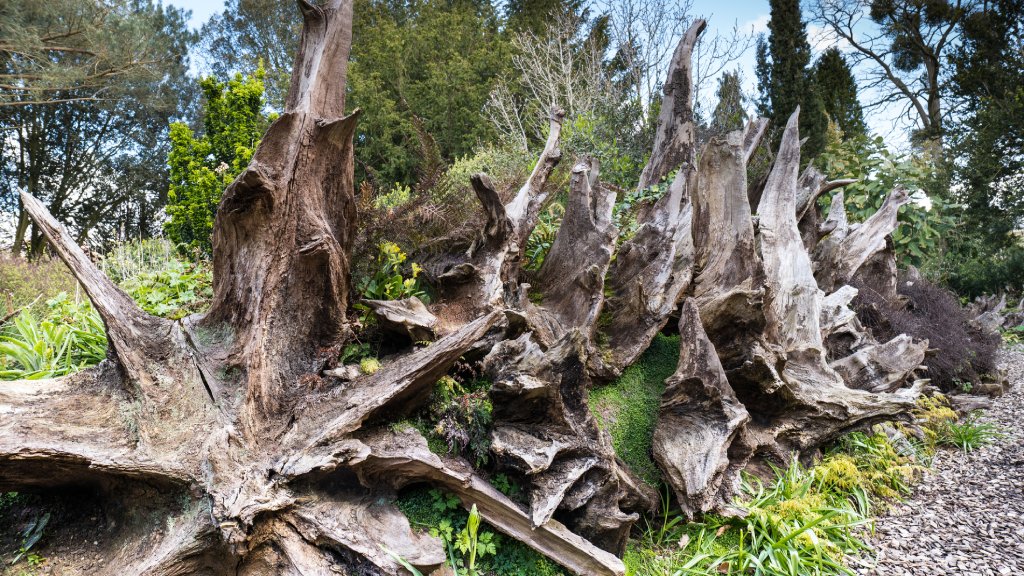Stumpery Garden Ideas: Turning Logs Into A Lovely Garden
If you have broken or felled tree stumps available, check out some garden stumpery ideas and create a charming shady corner of your yard or garden.


A stumpery is not a new gardening concept. It dates to Victorian times when gardeners grew shade-loving ferns among the pockets of upturned tree roots. Many gardeners embrace this idea as a creative way to utilize stumps, logs, driftwood, and other debris. King Charles is even a fan, and created a stumpery at Highgrove Gardens. If you have a shady nook in your garden and some leftover tree stumps or logs, use these ideas to make your own stumpery.
Basics of Stumpery Design
A stumpery has no rules. The idea is to utilize leftover stumps from trees that fell down or ones you’ve removed. An overturned stump with all its exposed roots is particularly attractive, but any stump will do. You can also use fallen logs, even those that have decayed or hollowed out.
Traditionally, a stumpery is in a shady woodland area. A stump garden presents a creative solution to a difficult, shady corner of a garden or yard. But you don’t have to be limited by this tradition. You can also use stumps or logs in a sunny spot to grow full-sun plants.
The basic design of a stumpery is to use the stump or log as a focal point and structure for growing other plants. You can grow plants around the stump or within the stump or log. If it has holes, hollow areas, depressions, or spaces between roots they can be filled with soil or potting mix and planted with an array of flowers or greenery.
Stumpery Garden Ideas
A stump or fallen log is an opportunity to get creative. Let these garden stumpery ideas get you started:
- If you have been blessed with an upturned stump and exposed roots, use it as a focal point. Pack soil or potting mix into the pockets between roots and add a variety of small, shade-loving plants, like ferns and hostas.
- Don’t limit the garden to the nooks and crannies of the stump and its roots. Grow shade plants around the stump to create a more complete garden. Use plants of various heights to create depth.
- Leave moss and lichen in place to add texture and visual interest to your stumpery. A shady, moist area should grow moss, but you can speed the process by getting moss from a garden center to add to the stumpery.
- If you have a fallen log that is beginning to rot, carve out some of the inside material and use it as a planter.
- Large pieces of driftwood are great foundations for a sunny stumpery. Use it to house succulents, cactuses, and other sun-loving plants.
- Embrace your stumpery as a wildlife refuge. The crevices and pockets of a stump or exposed roots create a habitat for frogs, birds, small mammals, insects, worms, and other critters. Consider leaving some of the pockets of the stump empty of plants. They’ll collect water and support wildlife.
Frequently Asked Questions
What Is the Best Wood for a Stumpery?
For a long-lasting stumpery, choose hardwoods like oak and beech. Softer woods like pine will rot much more quickly. You can still use softwoods but understand that they will begin to decay and change the look of that area of the garden.
Where Is the Best Place to Put a Stumpery?
Traditionally, a stumpery goes in a shady spot, but there is no need to limit yourself. Use these stumpery ideas to create a unique, artistic space anywhere you want. Obviously, the easiest place to create this kind of garden is where the stump is already located, since moving a stump can be difficult or impossible, depending on its size.
Gardening tips, videos, info and more delivered right to your inbox!
Sign up for the Gardening Know How newsletter today and receive a free copy of our e-book "How to Grow Delicious Tomatoes".

Mary Ellen Ellis has been gardening for over 20 years. With degrees in Chemistry and Biology, Mary Ellen's specialties are flowers, native plants, and herbs.
-
 Looking For Plants To Give You The Soft And Fuzzies? Try These 5 Fuzzy Leaf Plant Options
Looking For Plants To Give You The Soft And Fuzzies? Try These 5 Fuzzy Leaf Plant OptionsLovers of texture, drama, silver foliage and tactile plants will adore these special sensory garden additions. These fuzzy leaf plant options will leave you all aglow
By Susan Albert
-
 Get Ready For A Summer Of Hummers! Grow These Full Sun Hummingbird Plants and Flowers
Get Ready For A Summer Of Hummers! Grow These Full Sun Hummingbird Plants and FlowersIf you’re lucky enough to enjoy a sunny backyard, make sure you are maxing out on your pollinator opportunities and grow these full sun hummingbird plants and flowers
By Tonya Barnett